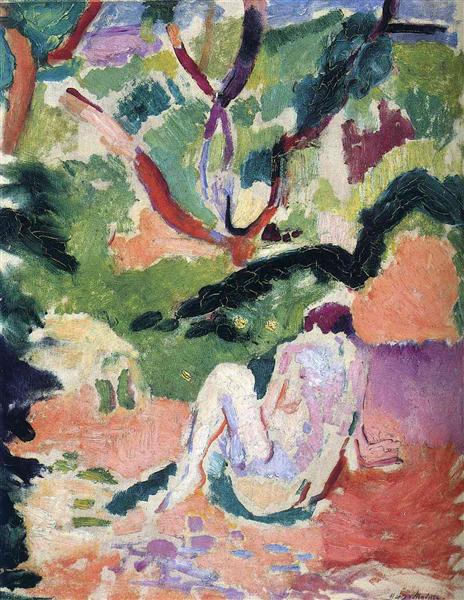Description
The painting "Nude in a Wood" executed in 1906 by Henri Matisse, stands as a sublime representation of his Fauvist period, that revolutionary movement that challenged the norms of color and form in the early 20th century. In this work, Matisse presents us with a central female nude figure, encompassed within a natural setting that transforms into the perfect framework for his chromatic and expressive exploration.
Observing "Nude in a Wood" closely, the female figure stands as a powerful focal point. This nude woman, with her relaxed posture and introspective gaze, seems immersed in an ethereal, almost dreamlike forest. The use of the nude here is not simply a homage to the beauty of the human body, but rather a celebration of the intrinsic connection between nature and the human figure. The way Matisse simplifies and stylizes the human form is worthy of analysis, revealing his skill in manipulating lines and proportions. The figure does not emulate photographic realism but encapsulates a more personal and subjective reality.
The colors in this work are vibrant and bold, a defining characteristic of Fauvism. Greens and blues dominate the vegetation surrounding the figure, while the woman herself is presented in shades of pink, oranges, and whites, creating a harmonious yet electrifying contrast. Matisse's brushstrokes, full of energy and without hesitation, convey a sense of dynamism and vitality, as if the very painting were breathing.
The choice of colors is also worthy of analysis. Instead of representing the authentic colors of nature, Matisse opts for tones that respond more to an emotional need than to a faithful visual record. This approach makes the forest and the figure become an interior landscape, a sort of window into the emotional and psychological world of both the artist and the viewer. The colors unfold with an almost musical freedom, where each tone and hue seem to vibrate in a visual symphony.
The background of the painting, although it evokes a sketched environment, does not denote a realistic perspective. The trees and leaves are painted through loose and gestural strokes that bring an abstraction to the setting, which accentuates the centrality and importance of the nude figure. This play between the abstract and the figurative is a characteristic mark of Matisse, who skillfully navigated between realism and a freer, more subjective expression.
Henri Matisse, one of the undisputed leaders of Fauvism, was deeply influenced by the need to free color from its traditional representative constraints. Analyzing his work, it is impossible not to mention the context of his time: a period of intense changes and artistic explorations. His work, along with that of other Fauvists, opened the door to new ways of seeing and representing the world, influencing subsequent movements and forever altering the trajectory of modern art.
"Nude in a Wood" from 1906, is not just a painting; it is a chromatic celebration and a revolution in the way of understanding pictorial representation. By immersing ourselves in this work, we become participants in Matisse's bold vision, where the boundaries between nature, the human body, and emotions blur into a kaleidoscope of colors and forms. The painting invites us to question, to feel, and to see beyond the obvious, gifting us a vision that is both intimate and universal.

